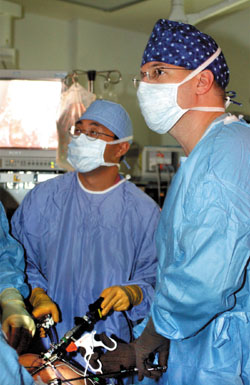
Drs. S. Duke Herrell, right, and Sam S. Chang perform the sixth laparoscopic prostatectomy procedure recently at Vanderbilt University Medical Center. (photo by Dana Johnson)
VUMC pioneers laparoscopic prostate surgery in Tennessee
Vanderbilt University Medical Center surgeons recently became the first in Tennessee to offer a new minimally invasive surgical technique that allows removal of cancerous prostates solely through the use of laparoscopes. The procedure uses small cameras and instruments to operate inside the body through several small half-inch incisions. Typically prostate surgery involves an incision of more than six inches.
Dr. S. Duke Herrell III, assistant professor of Urologic Surgery, and Dr. Sam S. Chang, assistant professor of Urologic Surgery, have performed the procedure, called radical laparoscopic prostatectomy (RLP), on a half-dozen patients thus far and have achieved excellent results.
In addition to significantly shorter recovery periods for patients, there are other advantages, for both patient and surgeon, by performing the procedure through the laparoscope.
“The area surrounding the prostate is very confined and can be difficult for the surgeon to reach manually, and to see very well. By performing the surgery with a laparoscope, we insert a camera into the pelvic area through a trocar. The area is then magnified and well illuminated with a bright light source. With the instruments we have now we can remove the cancerous prostate and minimize damage to surrounding nerves and tissue. The small instruments also allow for meticulous reconstruction of the urethra to the bladder which is important for urinary continence,” said Herrell.
“This is a new technique and we are approaching this as carefully as possible with the most experienced people possible,” said Chang. So far, the two surgeons have had patients come from all across the Southeast seeking the new procedure.
Chang completed a urologic oncology fellowship at Memorial Sloan Kettering and has performed hundreds of open radical prostatectomies. The two surgeons feel that by working together patients are offered the best of both worlds.
“We perform the procedures together and are both in the OR at all times. We are combining the expertise of Dr. Herrell, who is a fellowship-trained laproscopic and endoscopic surgeon, along with my experience with the open procedure, and have been able to provide this group of patients very promising results so far,” said Chang.
To date, VUMC patients have experienced less blood loss than typically associated with the open procedure and outstanding urinary continence. “The French have achieved results with the procedure that are equal to, or better than the open procedure,” said Herrell. “We don’t have enough data yet to make that claim, but so far we’re very encouraged.”
The use of laparoscopy in urologic surgery began with minimally invasive kidney procedures. Use of the laparoscope for prostate surgery has evolved in just the last few years. “We can now do procedures with a laparoscope, which were formerly done with an open procedure that would lay people up for weeks or months, and get them back to life’s activities much faster,” said Herrell.
He cites the growth in numbers of kidney-related laparoscopic procedures as an example of how the majority of U.S kidney surgeries are now performed this way.
Herrell and his associates perform several laparoscopic renal procedures a week, ranging from removal of large cancerous kidneys to meticulous correction and reconstruction of congenital kidney blockages. Herrell has served as an expert instructor for several years at national educational courses for surgeons who want to learn new laparoscopic techniques.
“We look at things differently than we did five or 10 years ago. I think surgeons tend to think of laparoscopy first when it comes to the kidney. But laparoscopic prostate surgery has only been possible within the last few years thanks to the development of new surgical techniques and new technology in the form of smaller instruments,” he said.
VUMC’s Department of Urologic Surgery, under the leadership of Dr. Joseph A. Smith Jr., is ranked by U.S. News & World Report as one of the nation’s best, long active in research for prostate cancer and benign prostatic hyperplasia (BPH), known also as enlarged prostate. Herrell says VUMC’s urologic surgeons have long since perfected the open technique for prostate removal. The open procedure remains the dominant choice for aggressive or advanced cases of prostate cancer.
“For urologic surgeons at Vanderbilt, the bar is already set very high for treating prostate cancer,” said Herrell. “Drs. Smith, Chang, and Michael Cookson are among world leaders in terms of experience with open radical prostatectomy. The next step for us is to work toward a goal that offers patients the best outcome with the fastest recovery.”
For a patient to be considered a candidate for RLP, the prostate cancer must be localized, typically not extending outside the gland. Patients must also have a PSA (prostate specific antigen) of less than 15, or more suitably less than 10, indicating the tumor hasn’t spread.
“There are a lot of options out there right now to treat prostate cancer, such as radiation, radioactive seeding, and surgery. We are offering men a minimally invasive surgical approach to treatment, “ said Herrell. “I think men are judging more and more. They want their cancer cured, but they also want good outcomes as far as continence, potency, and just being able to get back to life.”













